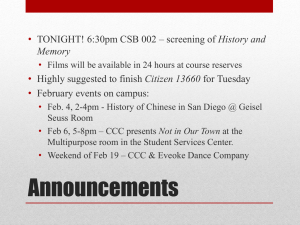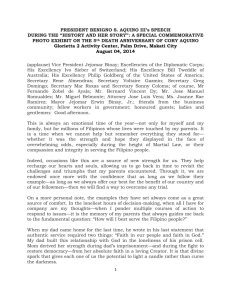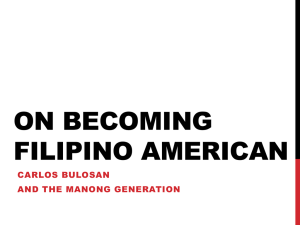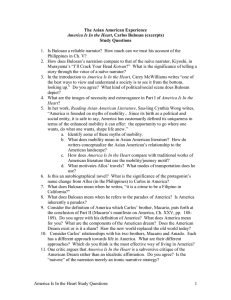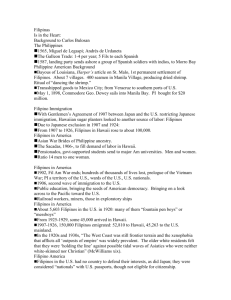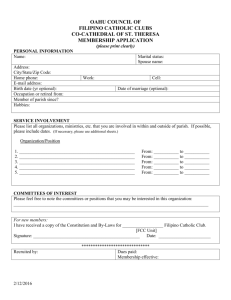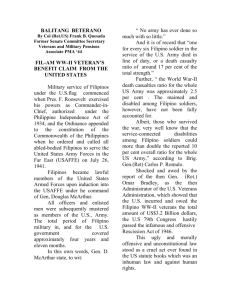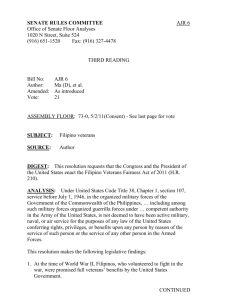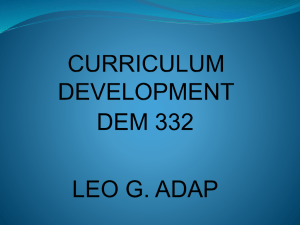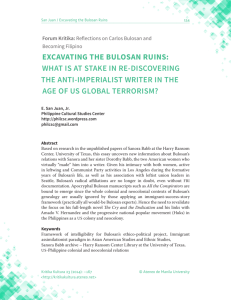“The Paradox of America”
advertisement
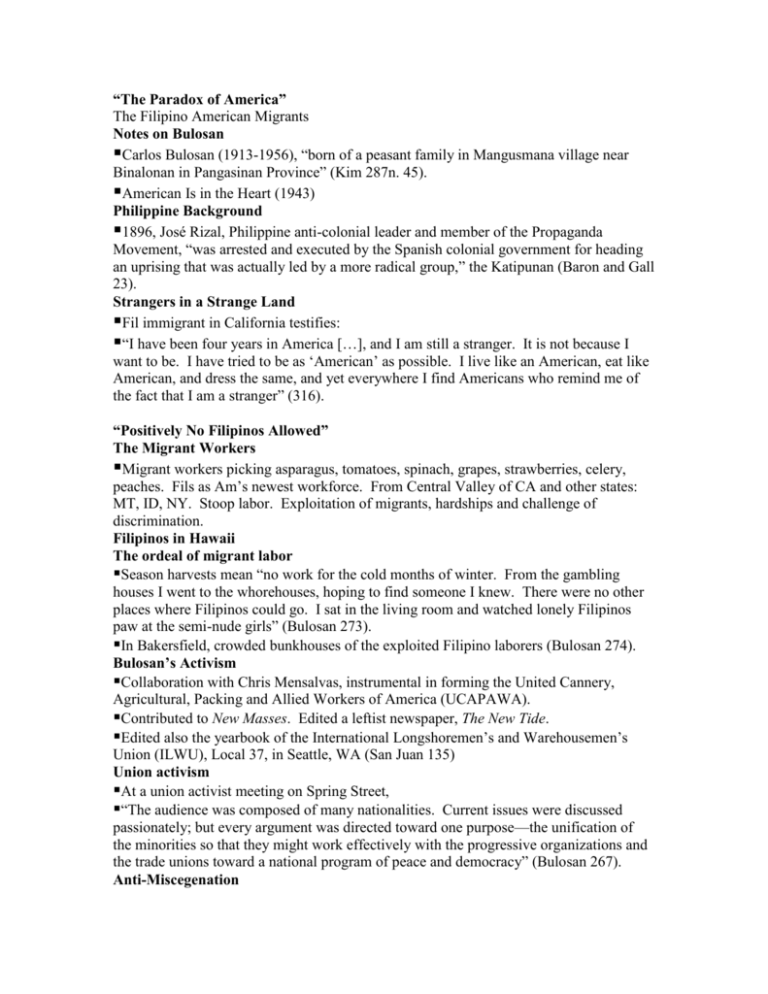
“The Paradox of America” The Filipino American Migrants Notes on Bulosan Carlos Bulosan (1913-1956), “born of a peasant family in Mangusmana village near Binalonan in Pangasinan Province” (Kim 287n. 45). American Is in the Heart (1943) Philippine Background 1896, José Rizal, Philippine anti-colonial leader and member of the Propaganda Movement, “was arrested and executed by the Spanish colonial government for heading an uprising that was actually led by a more radical group,” the Katipunan (Baron and Gall 23). Strangers in a Strange Land Fil immigrant in California testifies: “I have been four years in America […], and I am still a stranger. It is not because I want to be. I have tried to be as ‘American’ as possible. I live like an American, eat like American, and dress the same, and yet everywhere I find Americans who remind me of the fact that I am a stranger” (316). “Positively No Filipinos Allowed” The Migrant Workers Migrant workers picking asparagus, tomatoes, spinach, grapes, strawberries, celery, peaches. Fils as Am’s newest workforce. From Central Valley of CA and other states: MT, ID, NY. Stoop labor. Exploitation of migrants, hardships and challenge of discrimination. Filipinos in Hawaii The ordeal of migrant labor Season harvests mean “no work for the cold months of winter. From the gambling houses I went to the whorehouses, hoping to find someone I knew. There were no other places where Filipinos could go. I sat in the living room and watched lonely Filipinos paw at the semi-nude girls” (Bulosan 273). In Bakersfield, crowded bunkhouses of the exploited Filipino laborers (Bulosan 274). Bulosan’s Activism Collaboration with Chris Mensalvas, instrumental in forming the United Cannery, Agricultural, Packing and Allied Workers of America (UCAPAWA). Contributed to New Masses. Edited a leftist newspaper, The New Tide. Edited also the yearbook of the International Longshoremen’s and Warehousemen’s Union (ILWU), Local 37, in Seattle, WA (San Juan 135) Union activism At a union activist meeting on Spring Street, “The audience was composed of many nationalities. Current issues were discussed passionately; but every argument was directed toward one purpose—the unification of the minorities so that they might work effectively with the progressive organizations and the trade unions toward a national program of peace and democracy” (Bulosan 267). Anti-Miscegenation Threats to “white racial purity”: anxiety about hybridizing with “’the lower racial stocks’” and producing mulatto children. California as seeking protection “’against the peaceful penetration of another colored race’” (Takaki 329). Antimiscegenation “The Asian immigrants most inconvenienced by antimiscegenation laws were Filipinos, many of whom were and are of mixed origins—primarily Melayo-Polynesian, Spanish, and Chinese. Concern over a new type of ‘hybridization’ became increasingly hysterical in the late 1920s as anti-Filipino spokespersons called public attention to the tendency of Filipino men to seek the company of white and Mexican women at taxi-dance halls. At these clubs, patrons bought strings of tickets, which the hostesses tore off one at a time as they dance with the men, giving rise to the phrase ‘ten cents a dance’” (Chan 60). Antimiscegenation Los Angeles county sometimes issued marriage licenses to Filipinos and white women; “Anti-Filipino groups and individuals, including California’s attorney general, eventually sued Los Angeles Country to compel it to end this practice. In 1930 a superior court judge prohibited the Los Angeles country clerk from issuing a marriage license to Tony Moreno, a Filipino man, and Ruby Robinson, a white woman. Thus chastised, the county clerk stopped issuing licenses to Filipino-white couples” (Chan 60). Racial categories Salvador Roldan wanted to marry Marjorie Rogers. The 1931 court case and the subsequent anti-Filipino appeal. In Salvador Roldan v. L.A. County -End of antimiscegenation statutes “The majority opinion handed down in 1933 by the appellate court, based on an exhaustive reading of the works of nineteenth-century ethnologists, declared that since the most influential writer of the day divided homo sapiens into five racial groups— Caucasian (white), Mongolian (yellow), Ethiopian (black), American (red), and Malay (brown, the category to which Filipinos belonged)—Mongolians and Malays were obviously not synonymous. Thus couples like Salvador Roldan and Marjorie Rogers could wed” (Chan 60). “Only in 1948 were California’s antimiscegenation statutes declared unconstitutional, and it was not until 1967 that all such statues in the United States were removed from the books or lapsed from disuse” (Chan 61). Refused Service In Holtville, a Filipino comes into a restaurant with his American wife and child. The owner refuses them service. The Filipino comes back to ask to buy a bottle of milk for the baby. The owner says, “For your baby?” “Yes, sir.” The owner again: “You goddamn brown monkeys have your nerve, marrying our women. Now get out of this town!” He gives the Filipino a final blow, between the eyes. “The Pool Hall Was Their World” “The Bachelor Society” In the Manila Dance Hall : wearing their “magnificent suits,” they stand outside gambling houses, pool rooms and dance halls: “The dance hall was crowded with Filipino cannery workers and domestic servants. But the girls were very few, and the Filipinos fought over them. When a boy like a girl he bought a roll of tickets from the hawker on the floor and kept dancing with her […] the girl was supposed to tear off one ticket every three minutes [from friend Marcelo’s roll], but I noticed that she tore off a ticket for every minute. That was ten cents a minute.” Marginalization Carlos has to live in a red-light district: “What would happen to Eileen if she were to try to visit me here? What would I say if the police broke into our apartment? Was there a place in this vast continent where Filipinos were allowed to live in peace?” (Bulosan 259). Contradictory Messages “’The mockery of it all is that Filipinos are taught to regard Americans as our equals. Adhering to American ideals, living American life, these are contributory to our feelings of equality. The terrible truth in America shatters the Filipino’s dream of fraternity’” Anti-Filipino organizations: Liberty League of California Daughters of the Golden West Daughters of the American Revolution The Parent-Teacher Association Associated Farmers of California “They worked as one group to deprive Filipinos of the right to live as free men in a country founded upon this very principle” (Bulosan 287). The Women Who Help Carlos: Judith, brown-haired, works in a Solvang grocery store, reads to him. Dora Travers, member of the Young Communist League, encourages his writing Harriet Monroe, editor of Poetry: A Magazine of Verse Alice Odell, writer who reads him Thomas Wolfe’s Look Homeward, Angel, goes to the Soviet Union Eileen Odell gives him books; he writes to her from the hospital: she is “undeniably the America” he sought out during those “frantic days of fear and flight, in those acute hours of hunger and loneliness. This America was human, good, and real” (Bulosan, in Takaki 350). “The Old World Must Die” Macario, and the Filipino American Workers’ “Manifesto” (188-9) The Labor Movement (193-4) Carlos and José Hiding Out from the Thugs (196-7) Helen, the Strike-breaker (200, 203) The Unified Statewide Union Campaign (204) Mexican Labor to Break the Strike (206) A Political Awakening Carlos develops a vision of international revolutions and antifascist wars (Philippines, Russia, Spain, Western Europe, U.S.): “this multiracial spearhead of the struggle in the U.S. during the forties derives from the antifascist popular front around the world that informs the narrator’s search for a plausible coherent pattern, for some overarching purpose that would give meaning to the nomadic, deracinated existence of Filipinos in the United States” (San Juan 115). Social Organization of Filipinos In the 1930s, “in the midst of the Great Depression, labor conflicts erupted in the fields and orchards of the Pacific Coast. Since Filipino farm laborers were among the most militant strikers, they received some press coverage for their activities” (Chan 103). Bulosan as a chronicler of the Filipino American experience Carlos experiences the scattering of his family due to poverty and the search for livelihood; he finds a sense of belonging and companionship in the workers movement. Inspiration from the Philippine national hero and leader José Rizal, a role model for Carlos (Bulosan 46). Filipinos turned away from rental properties (Bulosan 256). A “reading odyssey”: “I felt that I was at home with the young American writers and poets. Reading them drove me back to the roots of American literature—to Walt Whitman and the tumult of his time. And from him, from his passionate dream of an America of equality for all races, a tremendous idea burned my consciousness. Would it be possible for an immigrant like me to become a part of the American dream? Would I be able to make a positive contribution toward the realization of this dream?” (Bulosan 251). Social organization and resistance Founding of the Committee for the Protection of Filipino Rights; campaign to win the right to become naturalized American citizens; and the bill introduced by Rep. Vito Marcantonio (Bulosan 284-5). The Filipinos “worked and lived in national terms, so that when they were maligned they thought their whole race was maligned” (Bulosan 287). Social organization “in the aftermath of the 1930 Watsonville riot, Filipino immigrants established community-wide organizations to better protect themselves. 1930, Filipino Community of Stockton and Vicinity, Inc. 1934, Filipino Community Center in New York City 1935, Filipino Community of Seattle, Inc. 1936, Filipino Community of Salinas Valley, Inc. 1937, Filipino Community of Yakima Valley Bulosan’s terms: Fascism and the Fascists (239): Fascist movement: “The movement toward nationalism and conservatism as opposed to internationalism and radicalism” (Webster’s Collegiate Dictionary) Faschisti: “An Italian organization, originated (1919) by patriots to oppose all the radical elements in the country. Under Benito Mussolini, it became identical with the government of the state, which it reorganized” Bulosan’s terms: Socialism: “A political and economic theory of social organization based on collective or governmental ownership and democratic management of the essential means for the production and distribution of goods” (WCD). Communism: “A system of social organization in which goods are held in common; any system of social organization involving common ownership of the means of the agents of production, and some approach to equal distribution of the products of industry” (WCD). Video: Between Two Worlds ( 1998) Directed by Cheo Hul About Asian American youths seeking to define their identities in America
